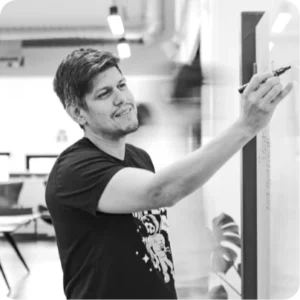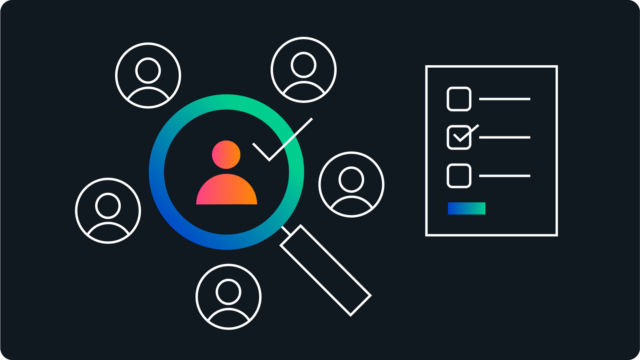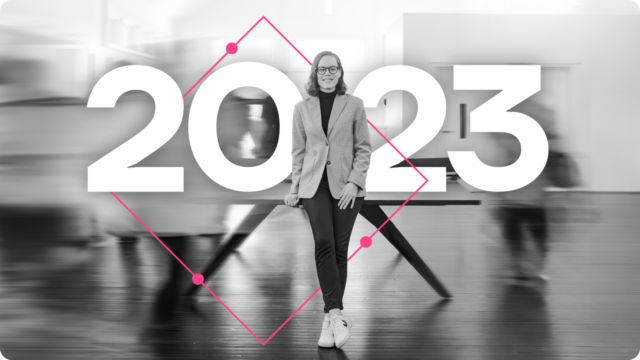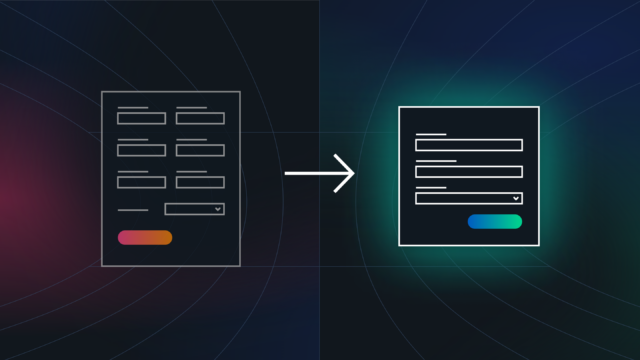AI in design: An art director’s perspective
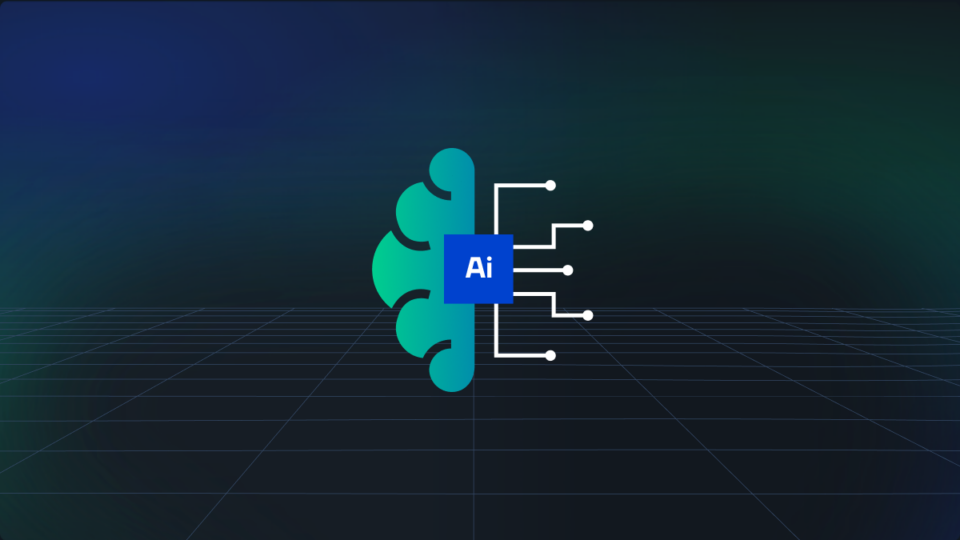
In the rapidly evolving world of design, staying ahead of the curve is not just a choice; it’s a necessity. As an art director at Tiller, I’ve witnessed the transformative power of AI in design. Here is a small glimpse into my experience with AI, some practical examples of AI in action, and its impact on our work in the agency.
Design in the age of artificial intelligence
The rise of AI in design has brought an unprecedented wave of innovation and efficiency to our industry. For designers, incorporating AI into our workflows isn’t just about staying relevant. It’s about harnessing a tool that can revolutionize the way we work.
The rapid evolution of AI technologies has indeed been met with a mix of exhilaration and apprehension within the design community. On one hand, there’s excitement about pushing the boundaries of creativity and efficiency to levels beyond what human capabilities alone could achieve. On the other hand, this drastic change has ushered in a sense of uncertainty and, for some, a jolt of shock. The skills and processes that have traditionally defined designers are being challenged by algorithms and machines that can learn, adapt, and create. Questions arise about the value of human creativity in the age of AI, the future of design jobs, and the ethics of AI-generated content.
We’re in a period of adjustment, where the familiar landscape of design is being reshaped by digital innovation. And there’s no doubt — these changes are challenging for designers and businesses to navigate. But in the face of uncertainty, I encourage you to ask yourself, “What’s possible?” and dive in.
Why designers should embrace AI in design
As designers, we are responsible for creating positive brand experiences. As advocates for design excellence, we should be constantly seeking new ways to elevate the brands we touch and strengthen the businesses behind them.
Here are a few ways we can use artificial intelligence in design to do just that…
Unlock new efficiencies in the creative process
We can now leverage AI in graphic design software like Figma and Adobe Suite to work faster and increase our creative output. AI-powered image editing and dynamic content generation can simplify previously time-consuming tasks such as background removal, color correction, and image retouching — all with a click of a button.
For example, if you’re designing a website heavy on photography, you can use AI to edit and standardize the images for online display automatically. By automating these repetitive tasks, designers gain more time to focus on creative innovation.
For companies that need high-quality design on quick turnarounds, AI can create significant production efficiencies and help marketing teams meet strict deadlines without sacrificing creativity.
Create more customized experiences
AI enables us to create custom, on-brand images that integrate with specific color palettes and visually support nuanced copy. Without the support of AI, we are often constrained to generic stock imagery, time-intensive illustrations, or expensive photoshoots. By leveraging AI in graphic design, we can efficiently and inexpensively customize everything from ethnicity and age to occupation, wardrobe, environment, mood, and so much more.
Differentiate brands from competitors
Differentiating a brand from its competitors is crucial in any market, but especially in saturated markets like SaaS. AI presents a unique opportunity for brands to gain a competitive edge through creative differentiation.
AI enables designers to go beyond generic stock images and craft unique visual content tailored to a brand’s specific narrative and use cases. For example, we work with a patient communication software company that markets to multiple healthcare verticals. Using AI, we can craft unique, industry-specific imagery that’s relevant to each segment. And we can finally avoid using that stock image of the smiling blonde-haired nurse with a pearly white smile that seems to be on every single healthcare website.
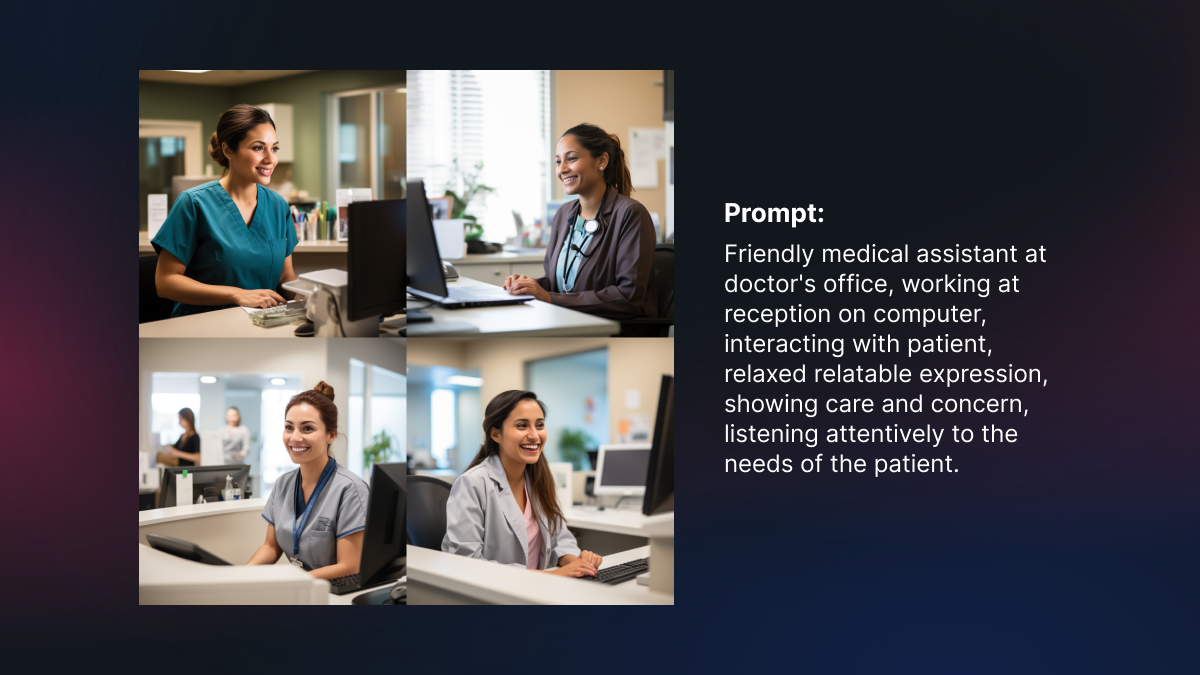
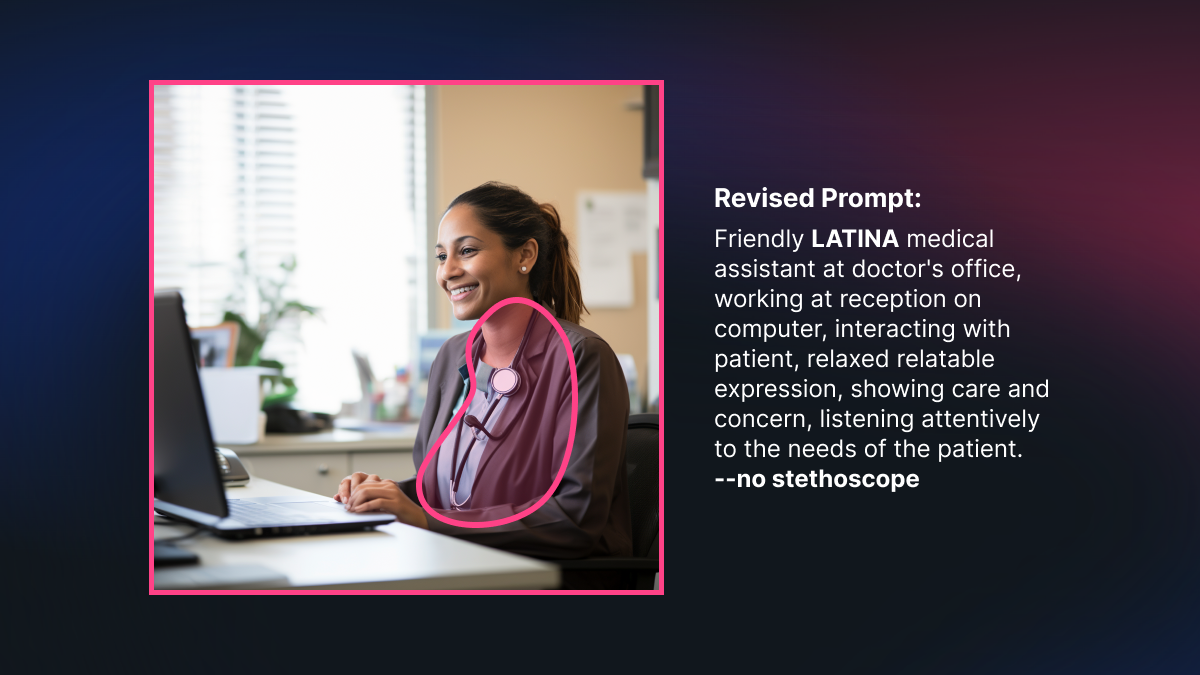
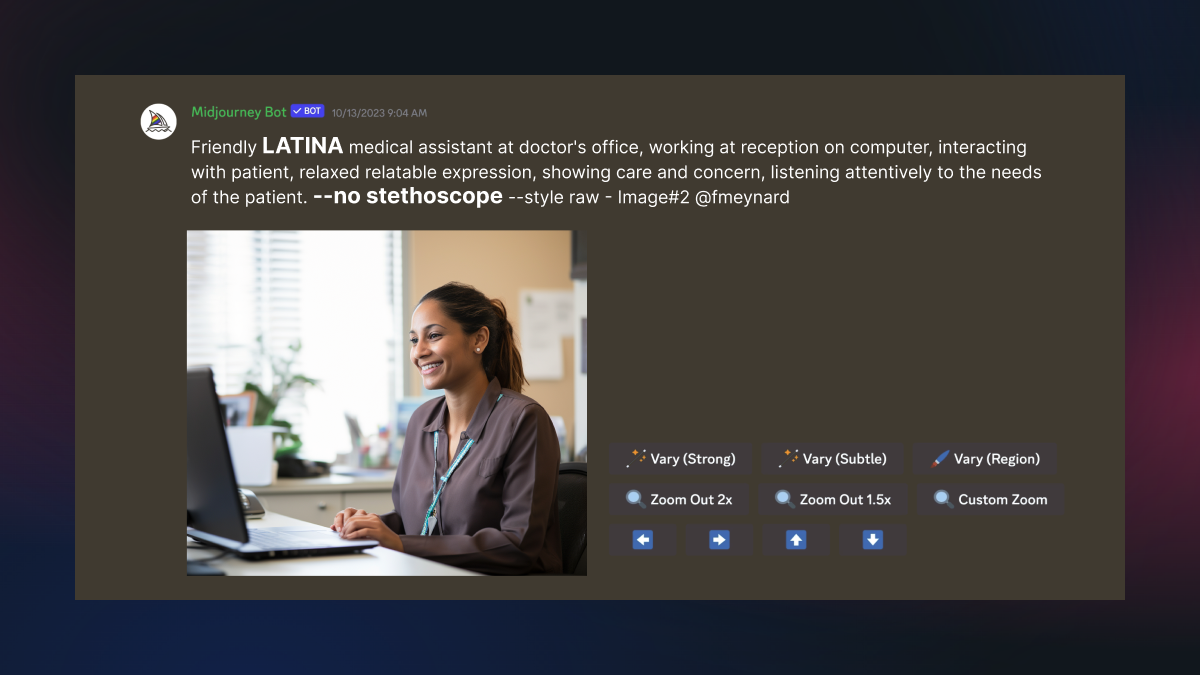
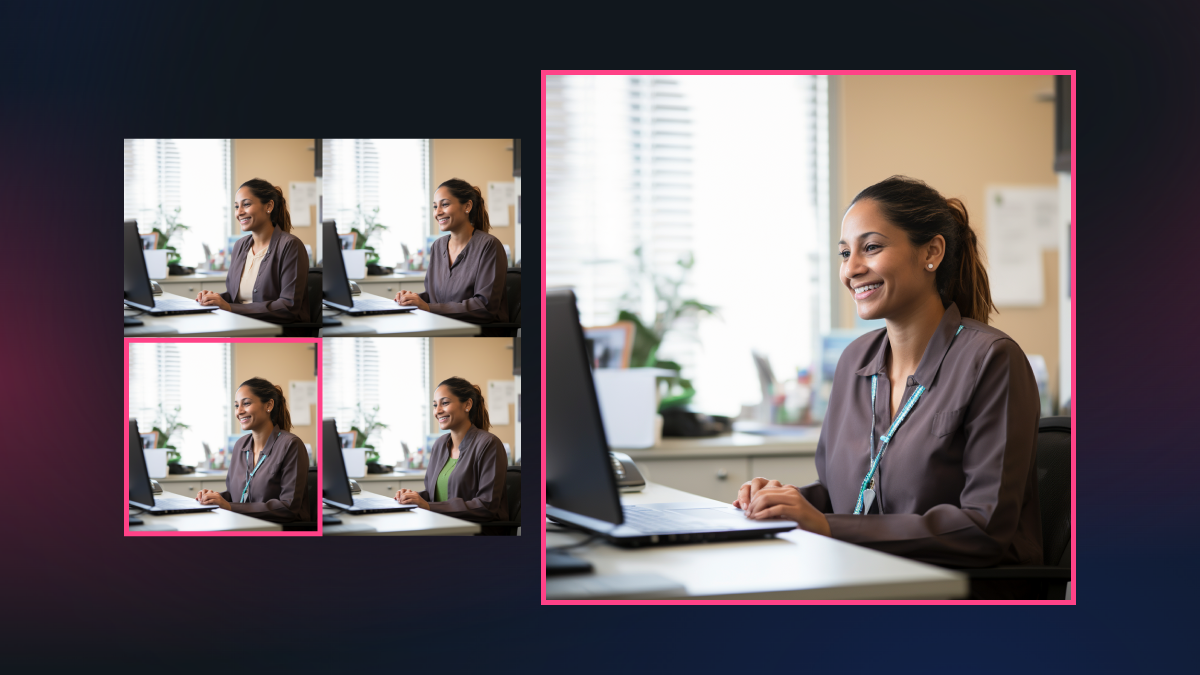
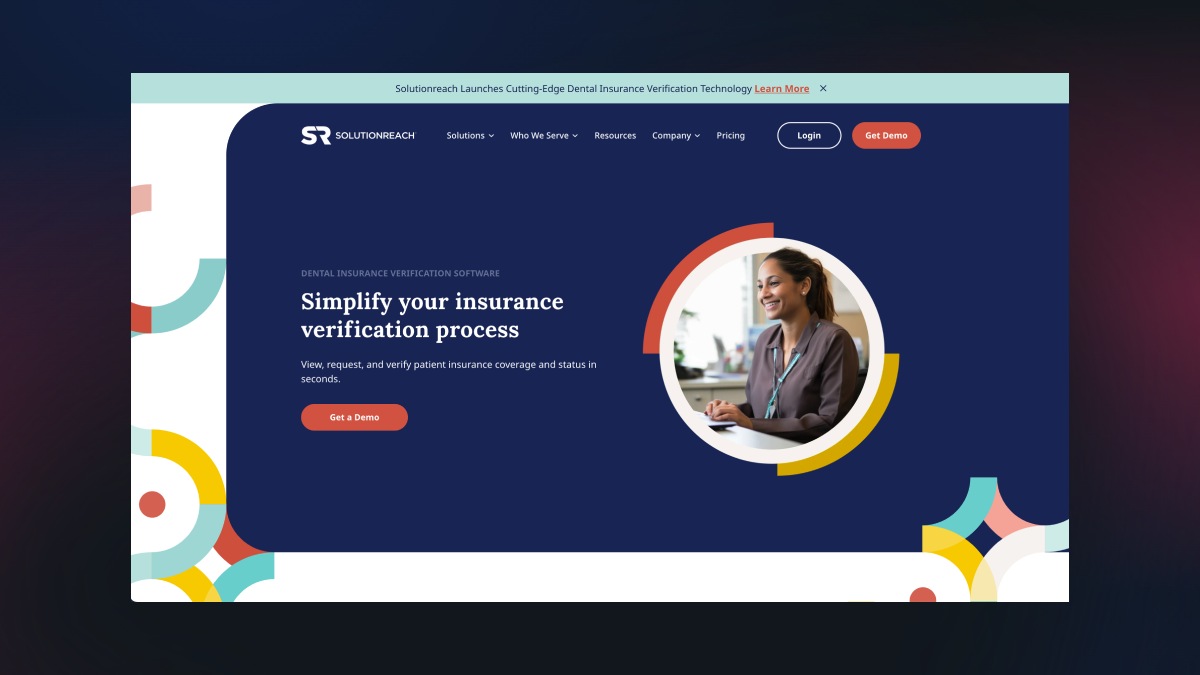
Enhance storytelling through visual narratives
AI has a powerful ability to interpret detailed prompts and produce content that aligns with a brand’s narrative, values, and vision. Designers can leverage artificial intelligence design tools like Midjourney to generate visuals that not only embody complex concepts but also resonate with the audience on a deeper emotional level.
Every aspect of visuals can be tailored — facial expressions, lighting, environments, and so much more. With AI, designers are better equipped to fine-tune imagery to evoke specific emotional responses.
Challenges with AI in graphic design
Generic design outputs
Despite their advanced algorithms, artificial intelligence design tools can still produce designs that feel quite generic. This is why AI still requires significant human intervention — we can take the initial output and further customize it to ensure our designs are truly unique and creative.
Designers, beware of leaning too heavily on AI for the final result. The brands you work with can’t afford to be generic — collaborate with AI, but never let your own creative brain collect dust.
Difficulty achieving a specific vision
Despite the wondrous capabilities of AI in design, the technology is still somewhat unpredictable. You could give an AI tool the same prompt twice and receive quite different results. To produce high-quality work with AI, you need to expect a certain amount of iteration and manual refinement.
Refining AI outputs to meet precise client demands does have the potential to be time-consuming, and in some cases, could even negate the efficiency. Remember, AI is one of many artificial intelligence design tools that may or may not be best suited to your project.
Loss of personal touch and craftsmanship
While collaborating on a Tiller Christmas marketing project, Tech for Tots: 10 Gifts to Raise the Next Tech CEO, one of our copywriters shared that while she recognizes and leverages the power of AI in her work, she never wants it to steal the joy that we, as humans, can experience in the creative process.
The shift towards AI-generated visuals can lead to a perceived loss of personal touch and craftsmanship in design work. And there is a fine line between leveraging AI to enhance creativity and delegating all of your creativity to AI. I encourage all creatives to keep this in mind and find ways to use technology to amplify your creativity without replacing it.
Examples of AI in design
At Tiller, we are actively exploring the value AI can add to our clients’ brands. Here are a few examples of how our team has leveraged AI to take B2B SaaS brands up a notch.
StellarAlgo: Bringing a new office space to life
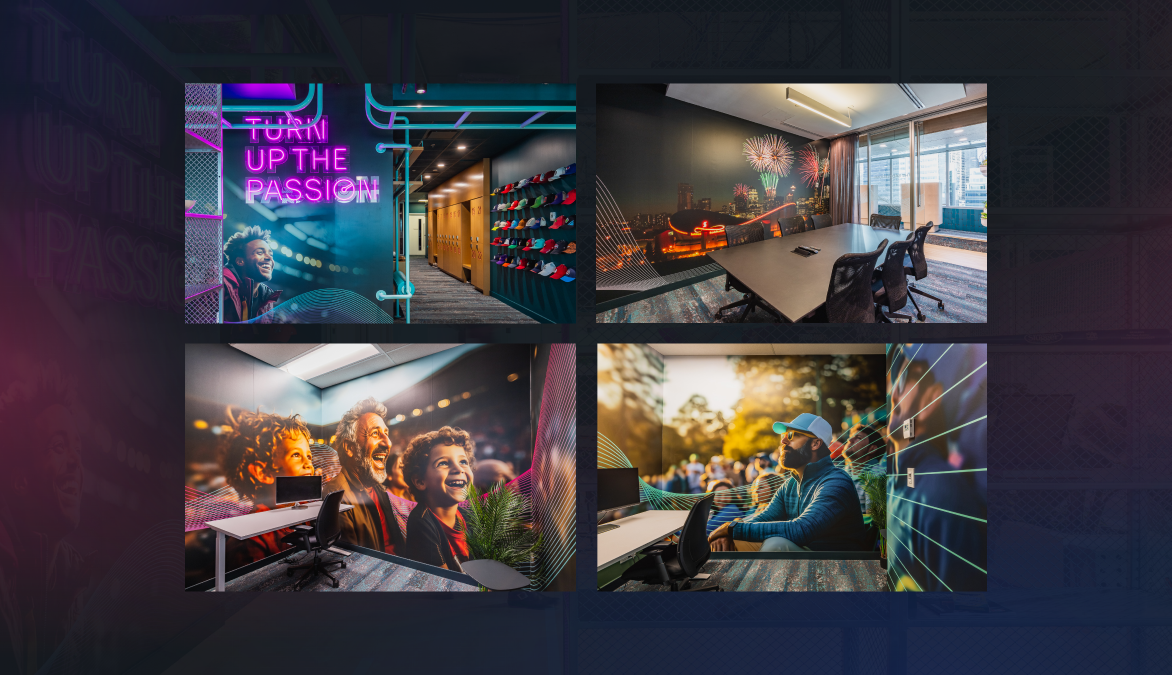
StellarAlgo, a fan engagement platform for sports and entertainment, engaged our team to design large-scale graphics for their new office space. We had recently redesigned the StellarAlgo brand identity and were deeply familiar with the brand’s visual language. Our mission was to collaborate with interior design company, Holland Design, to create an awe-inspiring office space that would inspire and energize the StellarAlgo team every day.
I was excited about the project, but I knew it came with a challenge: Most images of sports fans found in stock image marketplaces are horrible. Fans are frequently portrayed as loud, white males yelling at the top of their lungs, wearing team colors and obnoxious face paint. StellarAlgo wanted to move away from this generalization and represent the incredible diversity of fans and the settings they cheer in.
We used MidJourney and Photoshop Generative AI to generate images of fans of different ages, genders, and ethnicities in various settings — in the stadium, at the pub, or on the couch.
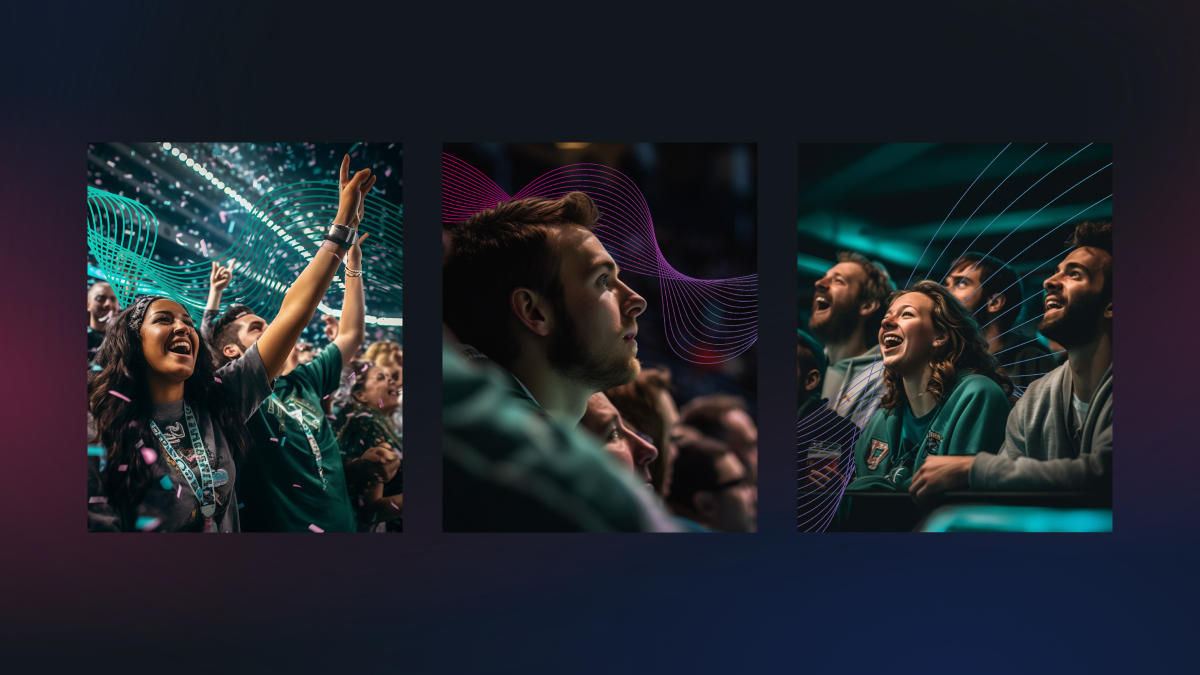
To align the images with the StellarAlgo brand and ensure they suited the office space, we refined the outputs:
- Corrected colors to match the brand’s palette
- Adjusted lighting to set the right mood
- Enhanced details for clarity in large formats
- Customized background elements with graphic devices
- Tweaked composition for narrative focus
These refinements ensured each image was not only on-brand but also visually compelling up close and from afar.
Now, in the process of working with AI, we did discover instances where designs appeared polished at first glance, but revealed imperfections upon closer inspection. We spotted unusual lip shapes, misplaced eyes, extra fingers — even an unexpected extra set of teeth!
To overcome these challenges, we used Midjourney’s “Vary” feature. This allowed us to pinpoint the exact areas needing refinement and make precise edits without overhauling the entire image. Through targeted adjustments, we successfully corrected these anomalies and made sure that each image met our high standards of quality and realism. No extra teeth!
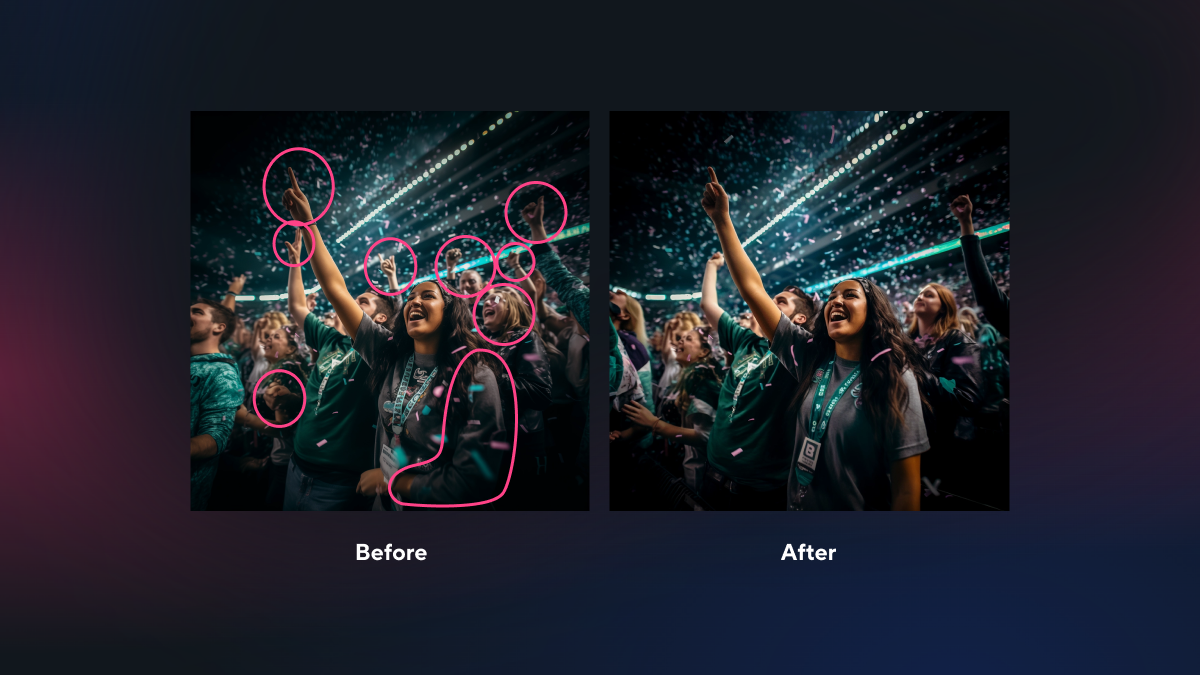
The large-scale format posed another challenge: image quality. AI came in handy once again, this time by automatically upscaling image resolution and clarity to capture the same crisp quality as the original images.
By leveraging AI, we were able to deliver incredibly unique graphic designs that captured the emotion and diversity of the world of sports and entertainment. Could we have delivered high-quality, beautifully creative work without AI? Absolutely. But by inviting AI into the process, we were able to enhance the quality of work and create a truly differentiated space.
Tech for Tots: Illustrating a children’s Christmas book
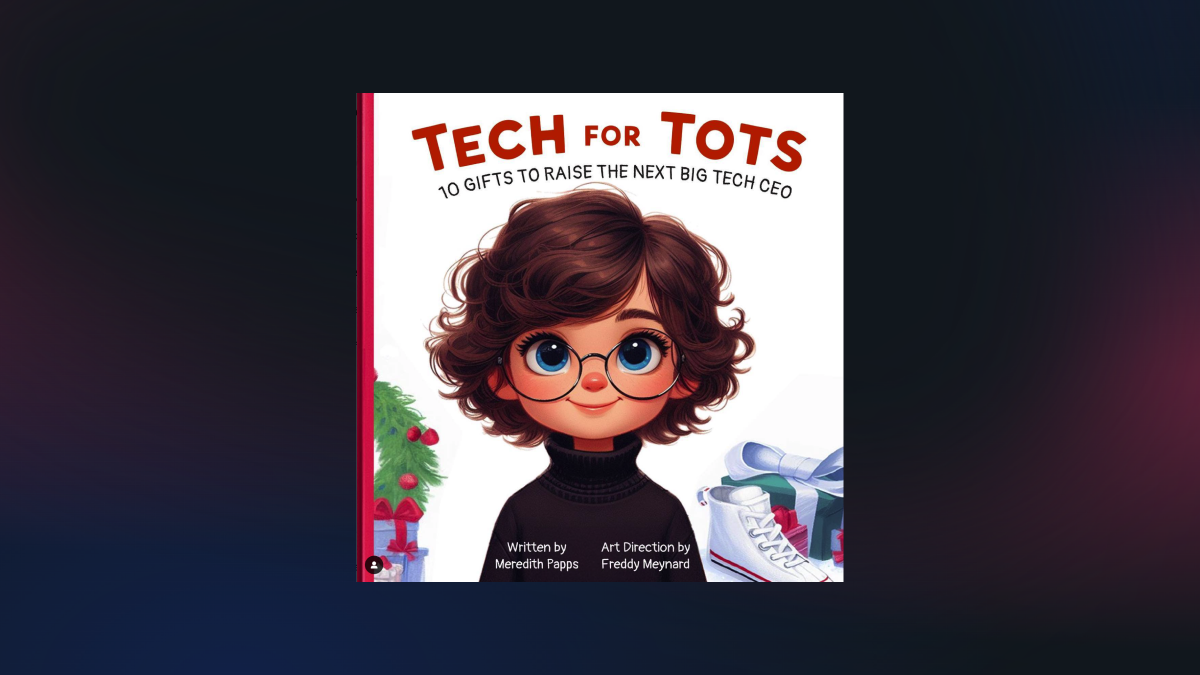
Crazy things happen when our marketing team gets together to brainstorm. A few weeks before Christmas, we decided to explore generative AI in design, specifically for illustrations. Our copywriter wrote a short rhyming story about raising a future tech CEO. Then, using the capabilities of Midjourney, DALL-E, and Photoshop Generative AI, we crafted detailed characters and scenes for each page.
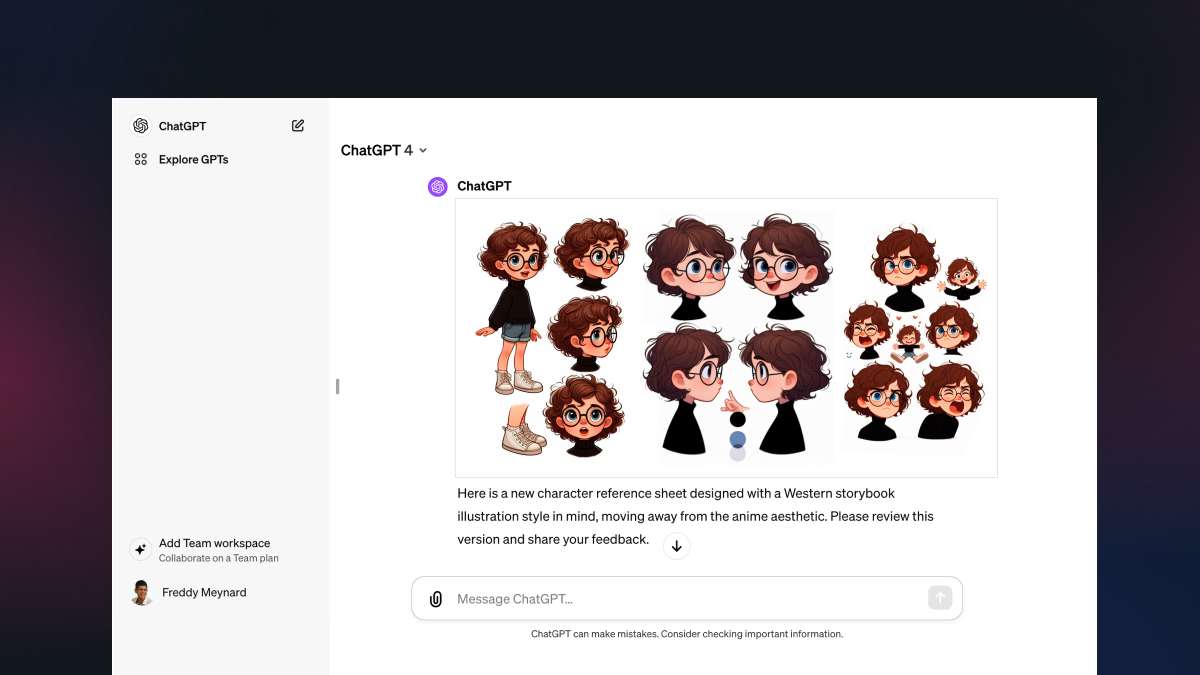
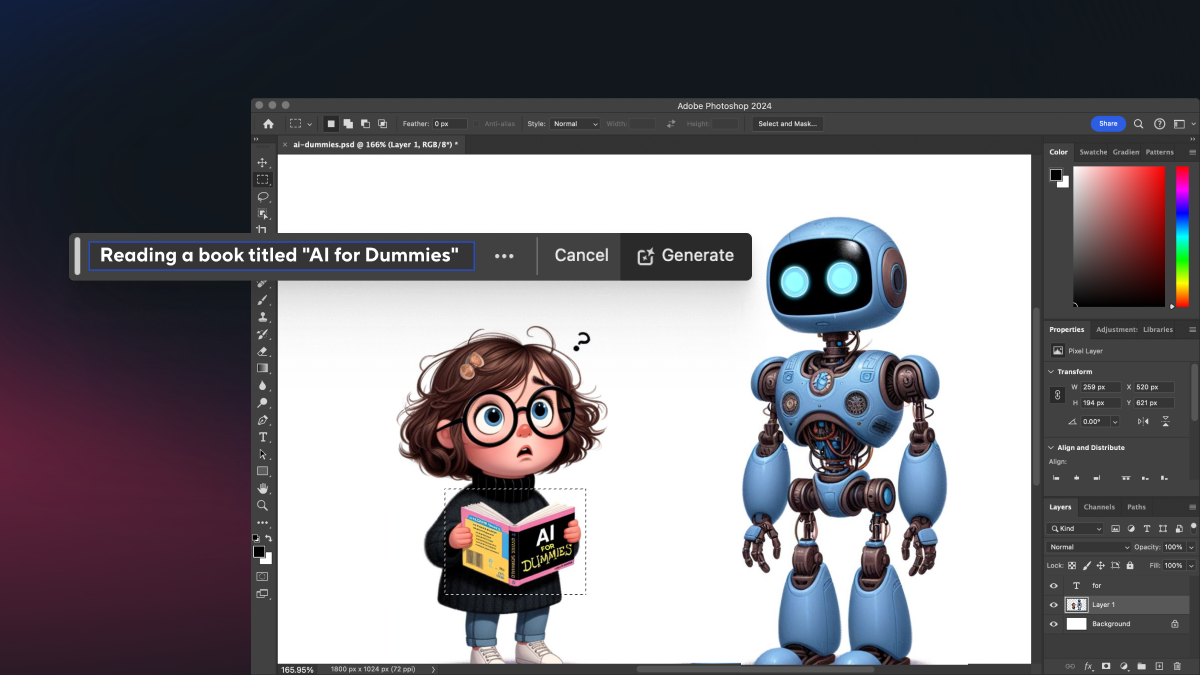
We used DALL-E to generate the initial concepts through detailed prompt modifiers like children’s storybook illustration, charming character design, digital painting, subtle texturing, and softened edges.
Using these modifiers and inspiration from the illustrative styles of Quentin Blake, Jesus Lopez, Aliaga Mirguseinov, Mo Mo, Josh Lewis, and Stevie Lewis, we developed a character reference sheet. Iterative, detailed prompts helped us generate our adorable future CEO, her parents, and sidekicks in a variety of clothing and silly settings. We fine-tuned these generated images using Midjourney and Photoshop Generative AI to ensure that they felt cohesive throughout the story.
The result? A sweet (and sarcastic) illustrated children’s book that showcases Tiller’s love for tech and our passion for pushing the boundaries of design.
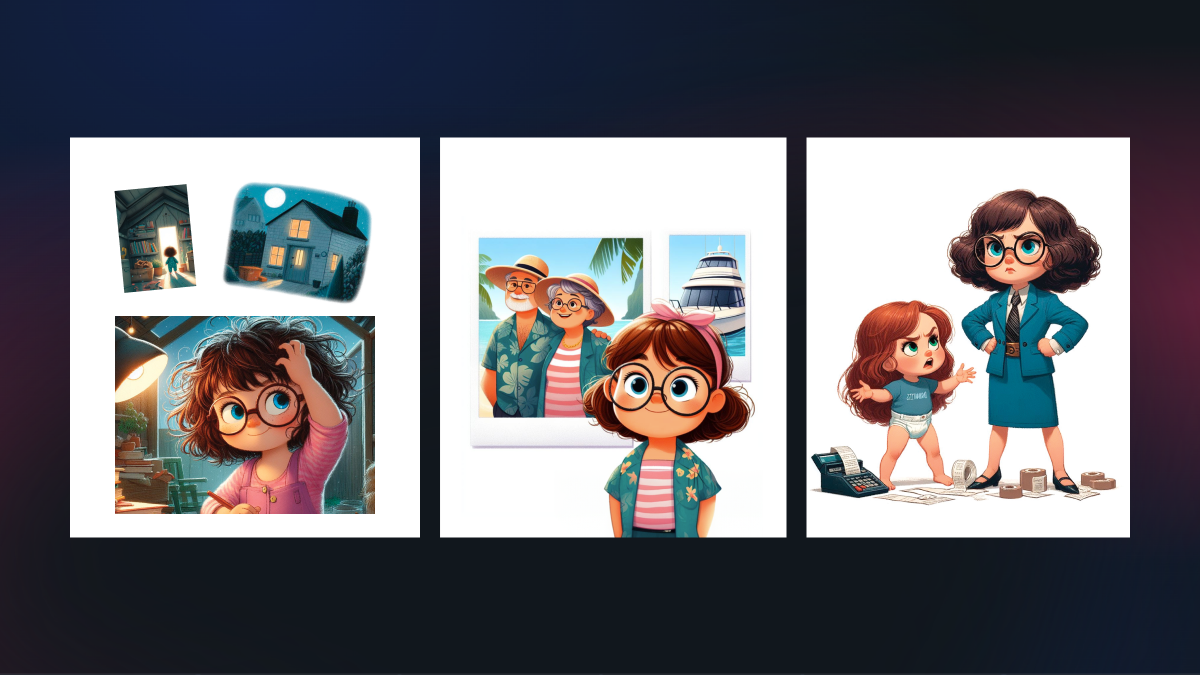
The possibilities with AI are truly endless
Using AI in design is not just about embracing technology. It’s about evolving and staying competitive in a rapidly changing landscape. From designers and writers to CEOs and CMOs, there is so much more to discover with artificial intelligence.
So, what could AI do for your brand, your website, or your next project? You’ll never know until you try.
